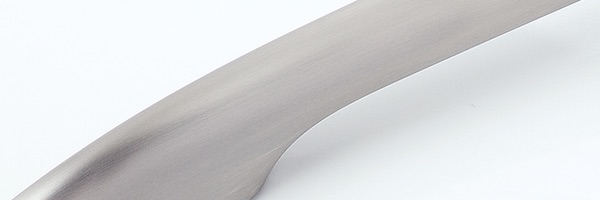By any count, there are over 150 grades of stainless steel available. Appliance stainless steel handle manufacturers typically use just four of these many options: 304, 439, 441, and 201 grade stainless.
Below we outline the defining characteristics of each grade and discuss why and when stainless steel handle manufacturers choose one over the other.
Grades of stainless steel are typically selected on the basis of three main characteristics:
- Formability – Each of the types of stainless steel noted above have different yield strengths. Some of the more complex shapes for appliance stainless steel handles — i.e., those with tight corner radii — require grades that can tolerate higher degrees of plastic deformation without any significant loss of strength.
- Corrosion Resistance – All of the grades of stainless steel on this list have a reasonable degree of corrosion resistance. Selecting grades with higher levels of resistance or opting for finishes to increase durability in this area can be important, though, for appliances, such as dishwashers, that frequently come into contact with solvents and water.
- Color – Stainless steel handle manufacturers go to great pains to match the color of their products to the color of surrounding elements such as door skins. This can be accomplished by using the same grade of stainless as the product that needs to be matched or through specialized finishing if using a different grade of metal.
304 Stainless Steel
Exhibiting the highest quality and best overall formability, 304 stainless is the most expensive of the typical grades used by appliance stainless steel handle manufacturers. It has less than 0.08% carbon content, making it extremely resistant to intergranular corrosion and often eliminating the need for any annealing, except as a stress reliever.
304 stainless steel also has high nickel content — in the range of 8–12 percent — which is one of the main reasons it is relatively expensive. This high ratio of nickel also gives 304 stainless its characteristic blue color and enhances its formability, especially in cases involving multi-draw processes or complex shapes such as hydroforming.
201 Stainless Steel
Type 201 stainless steel was originally developed to produce a stainless steel that wasn’t so reliant on nickel. With an average of 5.5 percent nickel content, it is significantly less expensive than 304 stainless steel but has formability characteristics that are close to those of metals in the 300 series.
With a tensile strength of 101,000 psi (vs. the 75,000 psi of 304 stainless), 201 stainless steel requires a lot of force to shape and can exhibit greater springback. With increased power and hold-down pressure, though, 201 can be made to perform much like 304 in many cases and has similar levels of corrosion resistance.
439 Stainless Steel
Stainless steel in the 400 series costs significantly less than any in the 200 or 300 series thanks to its 0.5% maximum nickel content, and 439 stainless steel is no exception. Appliance stainless steel handle manufacturers are often asked to use 439 to match kitchen appliance doors, which are often skinned with a 400-grade stainless.
Used widely in the auto industry for tubular parts such as exhaust systems or other components that require added aqueous corrosion resistance, 439 stainless is very pliable with a tensile strength of anywhere between 66,000–70,000 psi. Its low nickel content gives it a yellowish hue.
441 Stainless Steel
A variation on 439 stainless steel, 441 is sometimes used by stainless steel handle manufacturers for products that require higher temperature resistances, such as oven door handles.
Good Finishing Expands Your Options for a Stainless Steel Handle
Appliance stainless steel handles manufacturers are often faced with situations in which they have to balance aesthetic considerations, such as shape and color, with functional requirements such as corrosion and temperature resistance. And then, of course, there is always the question of cost.
These competing requirements can lead to situations where compromises need to be made in order to arrive at a solution that meets all criteria. Fortunately, a talented finishing department can provide a manufacturer with more options than might otherwise be available.
For example, consider a situation in which 201 stainless steel is selected for an appliance handle in order to reduce costs but the handle needs to look like 304 stainless in order to reinforce the high-quality nature of the appliance. Or, maybe 304 stainless’ added formability is needed to realize a unique hydroformed handle but that part also needs to exhibit the same color and brush pattern as the appliance’s 439 door skins. A good finishing department can solve either scenario.
Only a few stainless steel handles manufacturers in the world can offer this sort of guidance when it comes to selecting the right grade of metal and optimizing production to realize desired characteristics in a cost-effective manner. At Mills Products, we pride ourselves on being one of those elite suppliers and are not afraid to innovate in order to help our customers solve difficult manufacturing challenges.
Call us at 423-745-9090 or contact us today to find out how we can help you get a grip on your next handle stainless steel handle manufacturing project.


